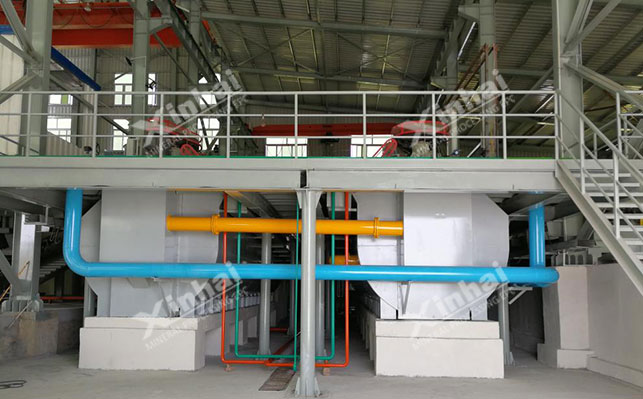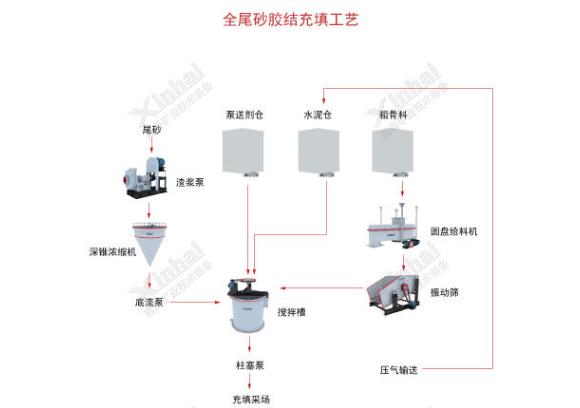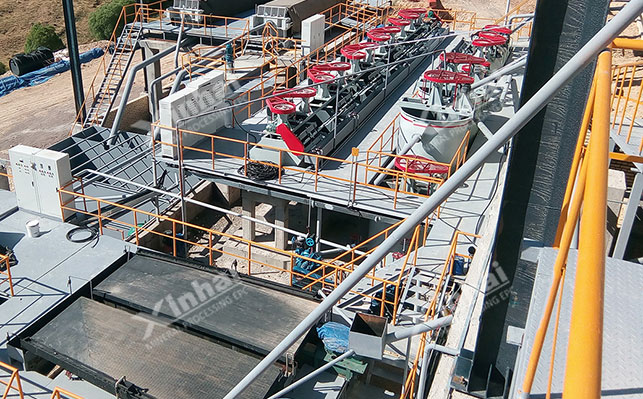
15311826613
Click to add WeChatFluorite is a major raw material required in industries such as metallurgy, chemical engineering, and building materials. Fluorite concentrate is obtained by purifying raw stones through mining and is used in various fields. However, the large amount of tailings produced during the fluorite beneficiation process poses challenges to the surrounding environment. Meanwhile, due to the inadequate early technology, some concentrate resources are forced to enter the tailings, resulting in resource waste. According to statistics, the global annual output of fluorite tailings has exceeded 120 million tons. As a major producer of fluorite, China's annual output accounts for 43%. It is very necessary to carry out effective treatment for this type of tailings. This article will introduce the treatment technology of fluorite tailings ponds.
From the perspective of resources: Fluorite tailings mainly come from the beneficiation process of associated fluorite in lead-zinc mines, tungsten mines, rare earth mines, etc., among which the fluorite tailings produced by the beneficiation of non-ferrous metal mines account for more than 70%. The content of calcium fluoride in typical tailings is usually within the range of 20% to 40%, the content of silicon dioxide is approximately 30% to 50%, and the content of calcium carbonate is about 10% to 25%. At the same time, it also generally contains heavy metal elements such as lead and zinc. The lead content in the tailings of some mining areas can reach 0.1%-0.5%, and the zinc content is 0.3%-1.2%. Therefore, some valuable elements in fluorite tailings have recyclable value. Even low-grade tailings still contain recyclable fluorite resources, which can be used in the production of building materials and as raw materials for the chemical industry. If tailings are treated through scientific methods, not only can the safety risks of tailings ponds be reduced, but also the goal of "tailless mines" can be achieved, enhancing the social image and sustainable development capacity of enterprises.
From an environmental perspective, the "Administrative Measures for the Prevention and Control of Environmental Pollution by Tailings" issued by our country clearly stipulates that tailings ponds must be equipped with anti-seepage systems, groundwater monitoring Wells and other facilities, and establish a full life cycle environmental management ledger. Data shows that untreated fluorite tailings, when piled up for a long time, can lead to an excessive rate of heavy metal content in the surrounding soil by over 60%, posing a potential risk to the ecosystem and human health. In addition, tailings dust can also affect the air quality in the surrounding areas and threaten the health of residents.
The commonly used fluorite tailings treatment methods mainly include three directions: first, tailings re-selection; second, tailings dry discharge treatment; third, tailings filling goaf areas.

When the calcium carbonate content in fluorite tailings exceeds 15%, secondary enrichment can be carried out through beneficiation technology. The commonly used fluorite re-selection method is mainly flotation. Depending on the different properties of the ore, different combined methods will be adopted to achieve enrichment.
Gravity separation - flotation method: Among them, gravity separation is usually used as a pre-selection stage to initially enrich fluorite and gangue with significant density differences. After gravity separation, about 30%-50% of low-density gangue minerals can be discarded. Flotation serves as the main mineral processing step. During the flotation process, the effective separation of fluorite from the remaining gangue minerals is achieved by regulating the reagent system.
Magnetic separation - flotation method: When magnetic minerals are associated with fluorite tailings, magnetic separation pretreatment can be carried out first to remove magnetic impurities in the tailings (the content of magnetic impurities can be reduced by more than 80%), so as to reduce their interference with the flotation process. Then, the flotation operation is carried out. During the flotation stage, by using flotation reagents, fluorite can be effectively separated from other impurity minerals.
Dry tailings discharge of fluorite tailings is an important means to achieve tailings reduction and resource utilization. According to the moisture content requirements, adopting different types of tailings dry discharge processes can effectively reduce the moisture content. The tailings after dry discharge can be discharged to the tailings pond for storage, effectively reducing problems such as tailings dam failure and leakage. In addition, the fluorite tailings after dry discharge can also be used to produce aerated concrete, cement admixtures and other building materials, achieving the resource utilization of tailings. The common tailings dry discharge methods are shown in the following table:
| Process type | Equipment used | Applicable tailings type | Water content | Resource adaptability |
| Cyclone - thickening | Cyclone + thickening machine | Fine-grained, high-mud tailings | 45%-50% | Building materials, filling |
| Concentration- Filtration | Concentrator + Filter | Fine-grained tailings | 15%-20% | Building materials, chemical raw materials |
| Two-stage concentration-filtration | Cyclone + Concentrator + Filter | Tailings with fine mud content > 30% | 15-20% | High value-added utilization |
| Two-stage concentration-dehydration | Cyclone + thickener + dewatering screen | Coarse-grained tailings | 12-15% | Building materials, chemical raw materials |
| Two-stage thickening - segmented dewatering and filtration | Cyclone + dewatering screen + thickener + filter | Medium-fine tailings with a concentration greater than 10% | 15%-18% | Building materials, reclamation |
| Cyclone + dewatering screen + thickener + filter press | Fine-grained tailings | 9%-12% | High value-added utilization |
Tailings filling of goaf involves mixing tailings with cementing materials and then backfilling them into underground goaf areas. It is an effective means of ecological restoration and safety guarantee. This method can not only reduce the accumulation of surface tailings, but also prevent ground collapse. At present, the commonly used methods for tailings filling goaf in the mining field include full tailings cemented filling method, graded tailings cemented filling method, and tailings non-cemented filling method, etc.

The full tailings cementitious filling method: The fluorite full tailings produced by mineral processing are mixed with cement, fly ash, slag and other cementitious materials in a certain proportion to prepare filling materials with certain strength, which are then pumped through pipelines or transported by gravity to the underground goaf area. It is mostly suitable for mining areas with large mining depths and where surface subsidence is not allowed.
Graded tailings cementitious filling method: Fluorite tailings are classified into coarse-grained and fine-grained grades through a hydrocyclone or vibrating screen. Only coarse-grained tailings are mixed with cementitious materials for filling, while fine-grained tailings are treated separately. The multi-stage empty field method is suitable for subsequent filling.
Non-cementing tailings filling method: The dry tailings (with a moisture content of less than 10%) after dry discharge are directly conveyed to the goed-out area by belt conveyors, trucks or wind power. No cementing materials are needed. The filling body is formed by the self-weight of the tailings and mechanical compaction. It is mostly used for filling in small mines, abandoned mined-out areas and regions with strict environmental protection requirements but no need for high-strength support.
The residual fluorite content in this type of fluorite tailings is relatively high (CaF₂>20%), and it has a high economic recovery value. It is recommended to carry out re-selection and recovery - deep purification. The obtained tailings can be used as raw materials for building materials. Its re-separation process usually adopts a combined process of gravity separation and flotation for fluorite enrichment. The obtained re-concentrate can be deeply purified through methods such as acid leaching or high-temperature roasting to obtain high-purity fluorite concentrate.
The tailings after re-selection can be used to produce autoclaved aerated concrete blocks, cement admixtures and other products by adjusting the proportion of components such as SiO₂ and CaO.

Generally, if CaF₂<15%, it is considered low-grade fluorite tailings. The recoverable value of such tailings is relatively low. Usually, environmental safety is the priority. It is recommended to adopt the filling of mined-out areas or ecological restoration technologies for this type of tailings. The full tailings cement-filling process should be adopted, and the tailings should be mixed with cement and fly ash in a ratio of 1:8. Prepare the filling material with a concentration of 78%-80% for filling.
For fluorite tailings containing heavy metals such as lead, zinc and cadmium, stabilization treatment and long-term environmental monitoring must be carried out in accordance with the requirements of the Soil Pollution Prevention and Control Law. The treated tailings can be safely landfilled or resourcefully utilized according to the actual situation.
The above are the methods for treating fluorite tailings introduced from different perspectives. The treatment of fluorite tailings is a systematic project that requires comprehensive consideration of resource attributes, environmental protection regulations and economic feasibility. Under the impetus of policies, it has become a consensus in the industry to give priority to the treatment model that combines comprehensive utilization with ecological restoration. In the future, with the continuous advancement of green technological innovation, the treatment of fluorite tailings will undergo a transformation from pollution control to resource regeneration, opening up new paths for the sustainable development of the mining industry.